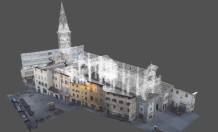articles

Faculty of Architecture and History of Art, University of Cambridge, Miguel Santa Clara and National Gallery, London
Lost buildings and artworks of Renaissance Florence to be reunited for the first time in hundreds of years
People will be able to step back in time and experience the extraordinary treasures of Renaissance Florence as they would have looked hundreds of years ago thanks to new University of Exeter research supported through the Digital Art History initiative of the Getty Foundation.
Lost buildings and art will be recreated and seen in their original locations via an innovative project that brings together 3D models and a location-aware app. Those leading the work hope it will lead to a revolution in how people experience history and think about one of the world’s most beautiful cities, as it developed through the centuries.
The app will allow people to walk through a number of Florence’s long-destroyed churches and buildings and see how paintings, altarpieces, furnishings and street shrines now in museums around the world would have looked like in the places they were originally designed for.
The project, led by Professor Fabrizio Nevola from the University of Exeter, is one of four art history projects funded by the Getty Foundation to promote the use of geospatial and digital mapping tools to document and analyse cultural sites around the world. The grants also represent a new approach that moves digital art history practice away from standalone solutions and toward shared learning opportunities.
“Technology is truly an area that benefits from collaboration, so we’ve brought this approach to our grantmaking,” says Joan Weinstein, acting director of the Getty Foundation. "Funding scholars who work together in a common area, in this case digital mapping, can help them learn from one another and push the whole field forward."
Each of the four projects will create or expand a GIS (Geospatial Information System) platform to manage geographic, cultural, and archival data. Several of the projects are also seeking to incorporate digital reconstructions, in the form of three-dimensional models and augmented reality, into their GIS platforms. Once created, these models will provide an enhanced understanding of the historical fabric of spaces, structures and artworks.
The Immersive Renaissance project based at Exeter will create 3D models of ‘lost’ buildings, using photogrammetric and digital modelling techniques. It brings together a team including Prof Nevola, Dr Donal Cooper, from the University of Cambridge and Professor Nicholas Terpstra, from the University of Toronto, as well as prestigious partnerships with the National Gallery (London) and Fitzwilliam Museum (Cambridge). Elements of three existing platforms will be integrated to construct a layered and interactive view of the art and architecture of Renaissance Florence: a project that provides access to historic census data through a GIS platform based on the 1584 Buonsignori map of Florence; a 3D modelling project; and a GPS-enabled mobile app.
The project will allow the multitude of Florentine artworks dispersed in museum and gallery collections worldwide to be seen in their digitally reconstructed original settings. The platform will highlight important buildings that have been demolished or altered and recreate lost spatial and architectural environments for displaced artworks.
Professor Nevola said: “It will really feel like you are there, witnessing these incredible pieces of art displayed in the way they were originally intended. This work will help us deliver a step change in how art and architectural history is presented. We hope to develop a system where people can use GPS, GIS and 3D/AR, to move seamlessly between investigating urban areas now and in the past to interpret art and architecture.”
More information about the Getty Foundation’s Digital Art History initiative can be found here - http://www.getty.edu/foundation/initiatives/current/dah/index.html
Date: 15 February 2019
